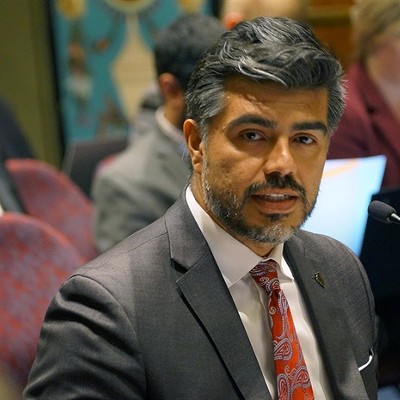Dickson Mounds Museum, which exhibited an excavated Native American cemetery, was transferred to the Illinois State Museum in 1965. Construction of a new museum was initiated in 1970, and the new museum with the excavated burials exhibited in one wing, opened in 1972. Bruce McMillan became director of the Illinois State Museum in 1977, and I became an anthropology curator later that year. During the 1980s, we became increasingly concerned that Native American sensitivities about exhibition and study of human skeletal remains deserved greater consideration. In 1989, the museum's leadership and the museum board recommended that the burial wing exhibition at Dickson Mounds Museum be closed. Following a press leak and a public outcry over plans to close the burial wing, Gov. James Thompson delayed the final decision on the closing and called for a public hearing and negotiations among government officials, Native Americans, archaeologists and local residents to find a compromise solution. In November 1991, incoming Gov. Jim Edgar announced plans to close and entomb the burial wing exhibition and make major improvements to the museum. Museum staff members planned new exhibitions and consulted with the Peoria and Miami Tribes of Oklahoma.
The Native American Graves Protection and Repatriation Act (NAGPRA) was signed it into law on Nov. 16, 1990 (Public Law 101-601, 25 U.S.C. 3001-3013; 104 Stat. 3048-3058). The initial Department of Interior Regulations (1995) established a process for repatriation of human remains, sacred objects and objects of cultural patrimony (i.e. objects with ongoing cultural importance to the group rather than to an individual) to descendants and federally recognized Native American tribes and Native Hawaiian organizations that could reasonably trace cultural affiliation to identified remains through "a preponderance of the evidence based on geographical, kinship, biological, archaeological, anthropological, linguistic, folkloric, oral traditional, historical or other information or expert opinion."
The Illinois State Museum was an early leader in the implementation of NAGPRA. The museum developed electronic inventories of culturally affiliated human remains, culturally unidentified human remains and associated grave goods required for publication on the National Park Service's NAGPRA website. In 1995, museum staff conducted consultations with federally recognized tribes on culturally affiliated and culturally unidentified human remains and associated grave goods. At the advice of the National Park Service and federal NAGPRA staff, they consulted with tribes likely affiliated with or interested in the remains as well as those with judicially established aboriginal lands in Illinois.
The museum repatriated all the human skeletal remains and associated grave goods culturally affiliated with the Peoria to the Peoria Tribe of Indians of Oklahoma, and in 2001, developed a curation agreement with the Peoria to curate the repatriated grave goods at the Illinois State Museum for educational purposes on behalf of the tribe. All agreed that consultation and repatriation work stimulated closer working relationships with tribes and enriched museum exhibitions and programs.
During my service as director, the Illinois State Museum followed NAGPRA regulations and our board-approved policies on collections management, human remains and destructive analysis. At no time did the museum willfully ignore NAGPRA regulations in order to hold onto collections of culturally unidentified human remains. Museum staff continued to use archaeological and historical information, along with information provided by tribes, to culturally identify human remains and associated grave goods. This information was critical to the repatriation of culturally affiliated human remains, and we hoped that it would help identify cultural affiliations for the culturally unidentified human remains. We were surprised by the few tribe-initiated claims for repatriation we received. We assumed that the tribal representatives, like museum staff, were struggling with numerous responsibilities and challenges.
In 2010, the Illinois State Museum and the Society for American Archaeology objected to a proposed new NAGPRA Rule. It exceeded the requirements of the 1990 Act by expanding repatriation to include culturally unaffiliated/culturally unidentified human remains and all associated grave goods so we argued that an amendment was needed rather than a rule. Also, some tribal representatives we consulted shared our concern that the recommended use of land cession treaties and adjudicated land-claim maps for determining claimants would favor the tribes that arrived later over the groups that lived in the same area earlier. When the rule passed, the museum abided by it. Museum staff members had contacted the tribes represented on the land claim maps and consulted on culturally unidentified human remains and grave goods. We thought we would receive numerous claims from tribes and tribal consortia after passage of the 2010 Rule, but we received few claims.
After the passage of the 2010 rule, the museum made repatriations to the Cherokee, Ho-Chunk, Inupiat and Chickasaw, but these were based on cultural affiliation. We continued to work on the inventory of grave goods for the culturally unidentified remains so we would be prepared for repatriation to tribes. We recognized the deep importance of repatriation to Indigenous tribes.
Across the country, museum stances on repatriation of human remains and grave goods have changed, and museums such as the Illinois State Museum, Burke Museum and Ohio History Connection, have added Indigenous tribal liaisons and curators as staff members. These additions have helped with consultations and repatriations. The slow progress on repatriation of culturally unidentified human remains at museums reinforces the need to dedicate full-time staff, including Indigenous staff, to these important endeavors. I applaud these actions and look forward to seeing what the future brings.
Since 2016, Bonnie Styles has served as the executive director of the Association of Science Museum Directors. She has worked alongside Native Americans on the Smithsonian Institution's Repatriation Review Committee for the National Museum of Natural History since 2018. She served as director of the Illinois State Museum System from 2005-2015 and before that was Associate Director of Science and Education (1999-2005), Director of Sciences (1988-1999), and Anthropology Section Curator and Chair (1977-1988). She hails from Arizona, but received her Ph.D. in Anthropology from Northwestern University. She has lived in Springfield for most of her career.

















